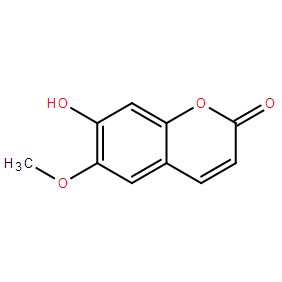| Cas No.: | 92-61-5 |
| SMILES: | OC1=CC(O2)=C(C=CC2=O)C=C1OC |
| Formula: | C10H8O4 |
| M.Wt: | 192.17 |
| Purity: | >98%, Standard References Grade |
| Sotrage: | 4°C for 1 year, -20°C for more than 2 years |
| Description: | Scopoletin is an inhibitor of acetylcholinesterase (AChE). |
| Target: | AChE[1] |
| In Vivo: | Scopoletin (2 μg, i.c.v.) increases T-maze alternation and ameliorated novel object recognition of mice with scopolamine-induced cholinergic deficit. It also reduces age-associated deficits in object memory of 15-18-month-old mice (2 mg/kg sc). Mice injected with 2 μg Scopoletin show an increased alternation rate of 71.3±2.5%[1]. |
| In Vitro: | Scopoletin (SCT) is identified as a putative inhibitor of acetylcholinesterase (AChE). Scopoletin enhances the K+-stimulated release of ACh from rat frontal cortex synaptosomes, showing a bell-shaped dose effect curve (Emax: 4 μM) [1]. Scopoletin inhibits PC3 proliferation by inducing apoptosis of PC3 cells. The IC50 of Scopoletin for inhibiting PC3, PAA (human lung cancer cell), and Hela cell proliferation is (157±25), (154±51), and (294±100) mg/L, respectively. Scopoletin induces a marked time- and concentration-dependent inhibition of PC3 cell proliferation. Scopoletin reduces the protein content and decreases the acid phosphatase activity (ACP) level in PC3 cells in a concentration-dependent manner. Cells treated by Scopoletin show typical morphologic changes of apoptosis by light microscope, fluorescence microscope, and transmission electronmicroscope. Apoptosis rate is 0.3 %, 2.1 %, 9.3 % and 35 % for Scopoletin 0, 100, 200, and 400 mg/L, respectively, and cells in G2 phase decrease markedly after being treated with Scopoletin[2]. |
| Cell Assay: | PC3 cells (5×107/L) 1 mL in exponential growth are seeded into four 24-well plates. The plates are incubated at 37°C in a humidified 5% CO2 atmospbee. After 24h, Scopoletin 33, 66, 133, 266, and 533 mg/L are added to wells (3 wells for each concentration for each plate). For control cells (3 wells foreach plate),only DMEM was added. The plates are incubated continually. The viable cells are counted by hemocytometer every day in the frist 4 d by Trypan blue dye exclusion method[2]. |
| Animal Administration: | Mice[1] C56BL/6N male, 4-6-month-old and 16-18-month-old mice are used in the behavioral studies. The mice are housed in groups of four in cages at constant humidity (50-55%) and temperature (22±1°C) on a 12:12 h light/dark cycle (7:00–19:00 h), with food and water ad libitum. Younger mice (4-6 months) are implanted with i.c.v. cannulas for application of Scopolamine (SCOP) and Scopoletin. The aged mice are injected with Scopoletin by the s.c. route. Experiments are conducted between 8:00 and 16:00 h. Mice with i.c.v. cannulas are randomly divided into four experimental groups: vehicle; SCOP 20 μg; Scopoletin 2 μg; and SCOP 20 μg plus Scopoletin 2 μg. The drugs are applied in 1 μL of vehicle solution (SCOP: saline, Scopoletin: 3 DMSO: 7 sterile water). I.c.v. injections are carried out 15 min before the start of the tests. Aged mice obtained Scopoletin s.c. 30 min prior to object memory test (vehicle: 1 DMSO: 1 EtOH, diluted with olive oil as required)[1]. |
| References: | [1]. Hornick A, et al. The coumarin Scopoletin potentiates acetylcholine release from synaptosomes, amplifies hippocampal long-term potentiation and ameliorates anticholinergic- and age-impaired memory. Neuroscience. 2011 Dec 1;197:280-92. [2]. Liu XL, et al. Effect of Scopoletin on PC3 cell proliferation and apoptosis. Acta Pharmacol Sin. 2001 Oct;22(10):929-33. |

 DC Chemicals' products qualify for U.S. tariff exemptions. We guarantee no price increases due to customs duties and maintain stable supply, continuing to deliver reliable research solutions to our American clients.
DC Chemicals' products qualify for U.S. tariff exemptions. We guarantee no price increases due to customs duties and maintain stable supply, continuing to deliver reliable research solutions to our American clients.





















